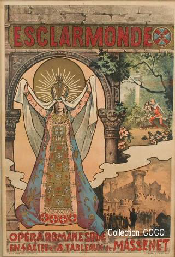
06 Apr 2008
MASSENET: Esclarmonde
Esclarmonde: Opéra romanesque in four acts and eight tableaux.
Idomeneo, rè di Creta: Dramma per musica in tre atti (K. 366).
Idomeneo, rè di Creta: Dramma per musica in tre atti (K. 366).
Così fan tutte, ossia La scuola degli amanti (K. 588). Opera buffa in two acts.
Così fan tutte, ossia La scuola degli amanti (K. 588). Opera buffa in two acts.
Die Zauberflöte: Singspiel in two acts, K. 620
Die Zauberflöte: Singspiel in two acts, K. 620
La Clemenza di Tito: Opera seria in two acts, K621.
La Clemenza di Tito: Opera seria in two acts, K621.
Le Nozze di Figaro (The Marriage of Figaro): Opera buffa in four acts, K492
Le Nozze di Figaro (The Marriage of Figaro): Opera buffa in four acts, K492
Il dissoluto punito ossia il Don Giovanni (K. 527): Drama giocoso in two acts
Il dissoluto punito ossia il Don Giovanni (K. 527): Dramma giocoso in two acts
Chérubin: Comédie chantée in three acts.
Marie-Magdeleine: Drame sacré in three acts and four scenes
Le Cid: opéra in four acts and ten tableaux.
Manon: Opéra comique in 5 acts and 6 tableaux
Thaïs: Comédie lyrique in three acts and seven scenes.
Fetonte: Dramma per musica in three acts.
La Partenope: Dramma per musica in three acts.
Medea (Médée): Opéra comique in three acts.

Esclarmonde: Opéra romanesque in four acts and eight tableaux.
Streaming Audio
Music composed by Jules Massenet. Libretto by Alfred Blau and Louis de Gramont after the French romance Partonopeus de Blois.
First Performance: 14 May 1889, Opéra-Comique (Théâtre Lyrique), Paris
| Principal Characters: | |
| Emperor Phorcas | Bass |
| Esclarmonde, his daughter | Soprano |
| Parséïs, her sister | Mezzo-Soprano |
| Enéas, a Byzantine knight, fiancé to Parséïs | Tenor |
| Chevalier Roland, Count of Blois | Tenor |
| Cléomer, King of France | Baritone |
| The Bishop of Blois | Baritone |
Synopsis:
Act I
Phorcas, the Emperor of Byzantium, abdicates in favor of his daughter, Esclarmonde. He bestows upon her magical powers on the condition that she must ascend the throne alone until the end of her twentieth year. Then, a tournament will be held in which the victor will become her bridegroom. In the meantime, Esclarmonde's face must remain veiled. Esclarmonde confesses to her sister, Parséïs, to be in love with the knight, Roland. King Cléomer, however, has decided to have his daughter, Bathilde, marry Roland. Esclarmonde sends her beloved to an enchanted island, where she will seduce him. There Roland awakens in the arms of the princess. She offers to become his bride and to give him honor and glory, provided that he never discloses her identity. The next day Roland departs to Blois, which is under seige by the Saracens. Esclarmonde promises him that she will visit him every night wherever he may be. She gives him a magic sword.
Act II
Roland, victorious over the Saracens, refuses the hand of the princess Bathilde without explanation. The Bishop of Blois becomes suspicious and determines to force Roland to reveal his secret. Esclarmonde arrives that night. As the two lovers embrace, the Bishop enters and exorcizes Esclarmonde Her veil is torn off. She bids goodbye to Roland and disappears, escorted by the spirits of the fire.
Act III
Phorcas awkens his daughter and enjoins her to renounce Roland. Otherwise, he will die. Desparate, Roland enters a Byzantine tournament seeking death. Roland wins the tournament and, of course, Esclarmonde. The princess may now express her love and reveal her face.